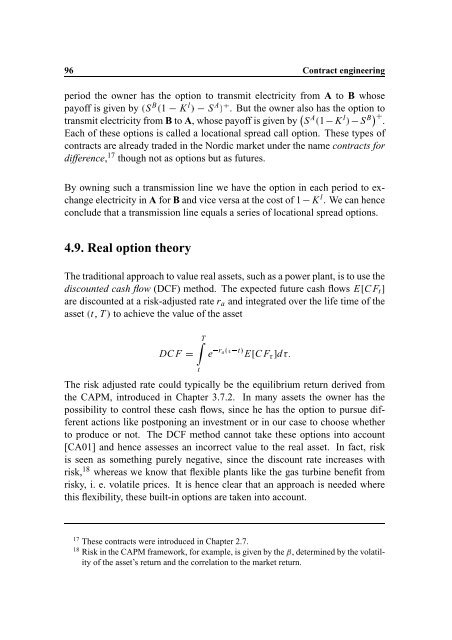Hedging Strategy and Electricity Contract Engineering - IFOR
Hedging Strategy and Electricity Contract Engineering - IFOR
Hedging Strategy and Electricity Contract Engineering - IFOR
You also want an ePaper? Increase the reach of your titles
YUMPU automatically turns print PDFs into web optimized ePapers that Google loves.
96 <strong>Contract</strong> engineering<br />
period the owner has the option to transmit electricity from A to B whose<br />
payoff is given by S B 1 K l › S A › œ . But the owner also has the option to<br />
transmit electricity from B to A, whose payoff is given by S A 1 K l › S B œ .<br />
Each of these options is called a locational spread call option. These types of<br />
contracts are already traded in the Nordic market under the name contracts for<br />
difference, 17 though not as options but as futures.<br />
By owning such a transmission line we have the option in each period to exchange<br />
electricity in A for B <strong>and</strong> vice versa at the cost of 1 K l . We can hence<br />
conclude that a transmission line equals a series of locational spread options.<br />
4.9. Real option theory<br />
The traditional approach to value real assets, such as a power plant, is to use the<br />
discounted cash flow (DCF) method. The expected future cash flows E C F t<br />
are discounted at a risk-adjusted rate r a <strong>and</strong> integrated over the life time of the<br />
asset t š T › to achieve the value of the asset<br />
DC F<br />
t<br />
T<br />
e«<br />
r a´µ « t· E C Fµ dķž<br />
The risk adjusted rate could typically be the equilibrium return derived from<br />
the CAPM, introduced in Chapter 3.7.2. In many assets the owner has the<br />
possibility to control these cash flows, since he has the option to pursue different<br />
actions like postponing an investment or in our case to choose whether<br />
to produce or not. The DCF method cannot take these options into account<br />
[CA01] <strong>and</strong> hence assesses an incorrect value to the real asset. In fact, risk<br />
is seen as something purely negative, since the discount rate increases with<br />
risk, 18 whereas we know that flexible plants like the gas turbine benefit from<br />
risky, i. e. volatile prices. It is hence clear that an approach is needed where<br />
this flexibility, these built-in options are taken into account.<br />
17 These contracts were introduced in Chapter 2.7.<br />
18 Risk in the CAPM framework, for example, is given by the ¹ , determined by the volatility<br />
of the asset’s return <strong>and</strong> the correlation to the market return.
















